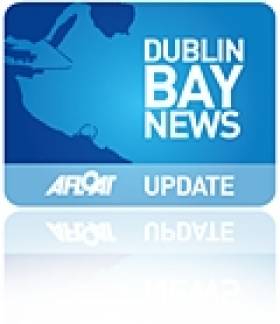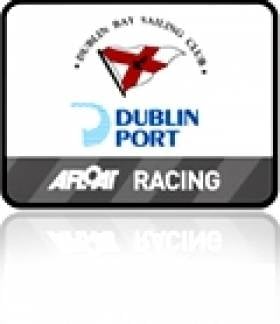Displaying items by tag: Royal Irish Yacht Club
Dun Laoghaire Sailing Clubs Say Future is in Leisure
Dun Laoghaire's future lies in tourism and leisure, according to a submission on the new 'master plan' for the busy harbour.
The Irish Times reports that the town's top sailing and yacht clubs, who have come together under the banner of Dun Laoghaire Combined Clubs, are putting aside their individual interests "in favour of a larger and longer-term vision for the harbour".
The clubs' submission urges a rethink on public access to both the shore and water sides of the harbour. Inprovements in linking the town with the harbour area are already a goal of the master plan.
"Properly developed with a marine tourism and leisure focus [Dun Laoghaire] can generate new and sustainable sources of income." they said.
Dun Laoghaire Combined Clubs comprises the 'big four' waterfront clubs - the National, Royal Irish, Royal St George and Dun Laoghaire Motor Yacht Club - as well as the Dublin Bay Sailing Club and the Royal Alfred Yacht Club.
The Irish Times has more on the story HERE.
Spot the mark was the order of the day on Dublin Bay for this afternoon's Dublin Bay Sailing Club (DBSC) race as boats, ships and racing marks appeared - and disappeared - in a sea mist that persisted all afternoon. The south easterly breeze that had prevailed this week means Forty foot mark, located just off Sandycove point, has got more than its fair share of use. Last Thursday's courses came in to play again this afternoon in Scotsmans bay.
David Williams of the Royal St. George Yacht Club sailing Phantom produced the same form as Thursday night to win from Michael Doorly in Aphrodite in a seven boat Dragon fleet. In the Flying fifteen's Frank Burgess of the National Yacht Club won both races. The SB3 results have not been recorded and nor have Cruisers Zero. John Maybury's Cruiser one entry, the J109 Joker, was a winner on IRC and Chris Moore's J109 Powder Monkey was the ECHO handicap winner. The rest of the DBSC results from this afternoon's race are below:
As the DBSC fleet sailed back to their moorings more boats appeared out of the mist around 4.30pm. It was the leading pack of the ISORA fleet returning from their second race to Rockabill and back. And bringing them home was Bay regular Derek Martin's Lively Lady. Click for our ISORA story here.
BENETEAU 31.7 - 1. Flying Machine (Conor O'Gallagher), 2. Prospect (Chris Johnston), 3. Bluefin Two (M & B Bryson)
BENETEAU 31.7 Echo- 1. Prospect (Chris Johnston), 2. Fiddly Bits (Kevin Byrne et al), 3. Flying Machine (Conor O'Gallagher)
CRUISERS 1 - 1. Joker 11 (John Maybury), 2. Something Else (J.Hall et al), 3. Aztec 3 (Peter Beamish)
CRUISERS 1 Echo - 1. Powder Monkey (C.Moore/M.Byrne), 2. Joker 11 (John Maybury), 3. Aztec 3 (Peter Beamish)
CRUISERS 2 Echo - 1. Dick Dastardly (B.Cusack et al), 2. Jawesome 11 (V.Kennedy/M.Dyke), 3. Smile (O'Connell/Healy/O'Sullivan)
CRUISERS 2 - 1. Jawesome 11 (V.Kennedy/M.Dyke), 2. Bendemeer (Lindsay Casey Power), 3. Smile (O'Connell/Healy/O'Sullivan)
CRUISERS 3 Echo - 1. Gung Ho (G & S O'Shea), 2. Hyflyer (John Barnard), 3. Cacciatore (Anne O'Callaghan et al)
CRUISERS 3 - 1. Gung Ho (G & S O'Shea), 2. Hyflyer (John Barnard), 3. Papytoo (M.Walsh/F.Guilfoyle)
CRUISERS 4 - 1. Maranda (Myles Kelly), 2. Ghrazel (Charles Pearson)
DRAGON - 1. Phantom (D.Williams/P.Bowring), 2. Aphrodite (Michael Doorly et al), 3. Susele (Michael Halpenny)
FLYING FIFTEEN - 1. Snow White (Frank Burgess), 2. The Big Bow Wow (N.Meagher/N.Matthews), 3. Fflogger (Alan Dooley)
FLYING FIFTEEN Race 2- 1. Snow White (Frank Burgess), 2. Hi Fibre (Michael McCambridge), 3. The Gruffalo (Keith Poole)
GLEN - 1. Glenluce (D & R O'Connor), 2. Glenshesk (L.Faulkner et al), 3. Glendun (B.Denham et al)
IDRA 14 FOOT - 1. Dunmoanin (Frank Hamilton), 2. Doody (J.Fitzgerald/J.Byrne), 3. Squalls (Stephen Harrison)
IDRA 14 FOOT Race 2- 1. Dunmoanin (Frank Hamilton), 2. Squalls (Stephen Harrison), 3. Doody (J.Fitzgerald/J.Byrne)
MERMAID - 1. Jill (P.Smith/P.Mangan), 2. Lively Lady (G O'Neill & M Hanney), 3. Kim (D Cassidy)
MERMAID Race 2- 1. Lively Lady (G O'Neill & M Hanney), 2. Jill (P.Smith/P.Mangan), 3. Kim (D Cassidy)
PY CLASS - 1. E Ryan (RS400), 2. F.Heath (Laser 1), 3. Desmond McCarthy (Laser 1)
PY CLASS Race 2- 1. F.Heath (Laser 1), 2. Desmond McCarthy (Laser 1), 3. E Ryan (RS400)
RUFFIAN 23 - 1. Ruffles (Michael Cutliffe), 2. Ripples (Frank Bradley), 3. Diane ll (Bruce Carswell)
SHIPMAN - 1. Gusto (C Heath), 2. Jo Slim (J.Clarke et al), 3. Whiterock (Henry Robinson)
SIGMA 33 - 1. White Mischief (Timothy Goodbody), 2. Gwili Two (D.Clarke/P.Maguire), 3. Popje (Ted McCourt)
SQUIB - 1. Femme Fatale (Joe O'Byrne), 2. Kookaburra (P & M Dee), 3. Nimble (Brian O'Hare)
SQUIB Race 2- 1. Femme Fatale (Joe O'Byrne), 2. Nimble (Brian O'Hare), 3. Kookaburra (P & M Dee)
WHITE SAIL CRUISERS Echo- 1. Sea Safari (Jacquelin Smith), 2. Calypso (Howard Knott), 3. Nirvana (Bernard Neeson)
WHITE SAIL CRUISERS - 1. Calypso (Howard Knott), 2. Act Two (Michael O'Leary et al), 3. Arwen (Philip O'Dwyer)
Royal Irish Yacht Club
“Some things in life extend beyond ordinary experience – the Royal Irish Yacht Club is such a place, once enjoyed it can only be equalled by return.”

The painting of the Royal Irish Yacht Club (above) is an extract from a larger painting of the club from the marina by one of the RIYC members, Desmond McCarthy.
For the latest RIYC news click HERE
Part of Club life is availing of the magnificent Clubhouse facilities where you can meet new people and develop lasting friendships. The Club hosts a wide variety of social events throughout the calendar year making it easy to keep in touch with fellow yachtsmen and women. As well as the regular scheduled events the Club caters for parties to celebrate the holidays, informal events, educational seminars, theme dinners, and all occasions. All this and more is brought to you by our highly qualified and professional catering team.
We are extremely proud of our catering department that facilitates all types of gatherings, both formal and casual, and always to the highest quality and standard. We have a number of venues within the Club each of which provide a different ambience to match your particular needs.
The Dining Room – This elegant room is steeped in club tradition. The décor creates an atmosphere of elegance and is the perfect venue for fine dining. Our menu offers a blend of the finest international cuisine using the freshest local produce. This is complemented by a fine selection of fine wines and unobtrusive friendly service. We know our kitchen will help you discover many culinary treasures.
The Upper Bar – A great meeting place for members. Relax with a glass of wine beside the fire and enjoy good conversation and the intimate surroundings. Our bar staff is committed to good service
The Drawing Room – A comfortable lounge tastefully decorated. Use it to relax and read the daily papers and journals. Bring a friend for tea/drinks. In winter the fires are ablaze creating that special warm atmosphere. This room is also used for cocktail receptions and private parties. We also provide daily a Traditional Afternoon Tea.
The Library – Recently restored has a wealth of sailing knowledge on its shelves. This Room is frequently used for meetings, seminars, business meetings, briefings, launches and small conferences. Reap the highest level of achievement in a traditionally peaceful and undisturbed working enviroment. It is the perfect private dining venue, for parties from 10 to 40, or cocktail receptions.
The Wet Bar – The venue for ‘many occasions’, The Wet Bar, since its refurbishment, has become the flagship for our function department as well for our Casual Dining programme. It is a multi-faceted room and can host a multitude of different functions. It is ideal for banquets, birthday celebrations, dinner/dances, weddings etc can also can be converted into a bistro for theme events and culinary journeys. It has a maximum seating capacity of 140. The centre of the room is dominated by a hi tech bar which sets the tone for intimate yet informal dining experiences. Our catering department will supply you with a comprehensive list of our extensive range of menus. We tailor make every function to suit your needs.
Weddings – The Dining Room at the Royal Irish is an ideal venue for your wedding reception. Beautifully decorated with old world charm, Waterford crystal chandeliers and exquisite views of Dublin Bay create the perfect setting. We cater for up to 90 guests. Superlative cuisine and unparalled service are the order of the day with waiter service all evening.
The Deck – the Club’s ‘al fresco’ venue. Relax and enjoy Irelands balmy days overlooking the Bay and the yacht basin. It is ever popular on Sunny evenings watching the sun set and enjoying the ambience of our wonderful club.
Sailing Suppers and Barbeques – During the sailing season we serve sailing suppers in the Wet Bar on Thursday and Saturday Evenings. Great food, great vibes after a great sail. In Good weather we serve BBQs on the deck for the yachtsmen returning from their evening sail.
(All details and image courtesy of the Royal Irish Yacht Club)
Royal Irish Yacht Club, Harbour Road, Dun Laoghaire, Co. Dublin. Tel: 01 280 9452, fax: 01 284 2470, emai: [email protected]
Have we got your club details? Click here to get involved






























































